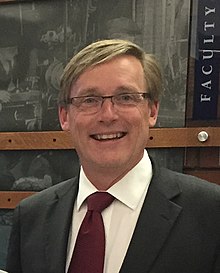Robert McMahan
| Robert K. McMahan | |
|---|---|

Robert McMahan in 2015
|
|
| 7th President of Kettering University |
|
|
In office August 1, 2011 – Present |
|
| Preceded by | Stanley R. Liberty |
| Personal details | |
| Born | 1961 (age 55–56) Florida, USA |
| Spouse(s) | Karen McMahan |
| Alma mater |
Duke University Dartmouth College |
| Profession | Professor of Physics, Academic Administrator |
| Institutions |
Harvard–Smithsonian Center for Astrophysics Dartmouth College University of North Carolina at Chapel Hill Western Carolina University Kettering University |
| Website | Office of the President |
Robert K. McMahan (b.1961) is an American physicist, professor, and entrepreneur who is the seventh and current president of Kettering University. McMahan assumed the position of President on August 1, 2011, succeeding Stanley R. Liberty.
McMahan received undergraduate degrees in Physics and the History of Art from Duke University in 1982 and a Ph.D. in Physics from Dartmouth in 1986 under Gary Wegner. After a postdoctoral appointment at the Harvard-Smithsonian Center for Astrophysics under Margaret Geller (1986-1989), and while also engaged in a number of corporate and public sector roles (see Corporate and Public below), he served as a research professor of Physics and Astronomy at the University of North Carolina at Chapel Hill from 1989-2008 as well as as a visiting scholar at Oxford University and the University of Durham (UK). He joined Western Carolina University in 2008 as the founding dean of the Kimmel School and Professor of Engineering prior to becoming the seventh president of Kettering University in 2011, where he also holds an appointment as a tenured Professor of Physics.
McMahan is known for computational modeling and observational work in white dwarf stars early in his career, then later for work in cosmology and extragalactic astronomy. As a graduate student he was involved with the Seven Samurai research group that postulated the existence of the Great Attractor. This effort resulted in the development of a methodology of estimating the distance to galaxies which, when applied, has become one of the most reliable ways to measure the total mass density of the universe. As a postdoc at the Harvard–Smithsonian Center for Astrophysics under Margaret Geller he participated in research that resulted in the development of maps of the large-scale structure of the universe, which led to the discovery of the Great Wall.
...
Wikipedia
